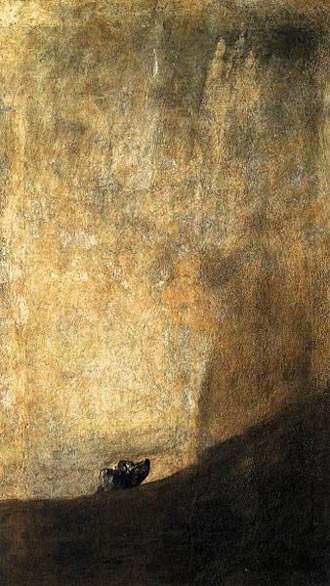
The Dog

|
The Dog
‘The Dog’ by Francisco De Goya is perhaps the most intriguing and meaningful piece of the “Black Paintings” series that the artist originally painted on the walls of his “la Quinta del Sordo” home in Spain.
It was not until 1873, when the Baron Émile d'Erlanger came into possession of “la Quinta del Sordo” that all fourteen paintings in the series were transferred to canvas. Unfortunately, during the process they lost a substantial amount of paint, causing irreparable damage. Eventually, they were donated to the State and sent to the Prado Museum in 1889. De Goya gave no titles to any of the works, leaving accurate interpretation close to impossible.
A dark and enigmatic painting, ‘The Dog’ has sparked an immeasurable amount of interpretations over the years, some more far-fetched than others. The viewer’s attention is immediately drawn to the only object in the painting, the head of a small dog that is looking up at either someone or something. Some believe that the animal is looking towards its death, while others found its presence to have a more profound meaning, suggesting that it is guiding lost souls to the depths of hell. The dog, alone and surrounded by nothingness, could be a symbol of abandonment and neglect. It could also represent fear and incapability as its body is buried in darkness, but also hope as its head is in the light. The pale yellow hues of the upper background produce a powerful contrast against the dark, sombre foreground. Never before had an artist implemented such emptiness of objects in a painting to exemplify utter solitude and void. One may assume that the composition represents Francisco De Goya’s emotions after his mysterious illness left him completely deaf.
Reviews
In July 2008, referring to De Goya’s dramatic style change after his loss of hearing, writer Tom Lubbock stated, “In his images of witchcraft, bull fights, nightmares, war, the Inquisition, sexual delight and sexual corruption, he [Goya] became a master of fantasy and documentary. Almost every artist alive today, from the crustiest to the most cutting-edge, will have a good word for Goya.” – Tom Lubbock “The Independent”
‘The Dog’ by Francisco De Goya is currently located at the Museo del Prado in Madrid, Spain.












